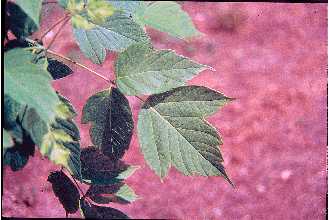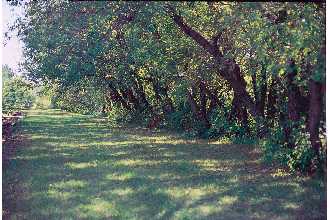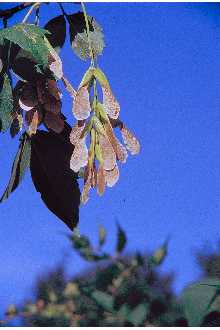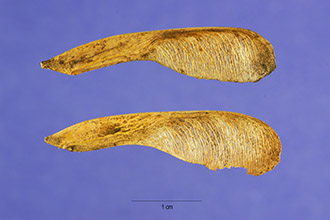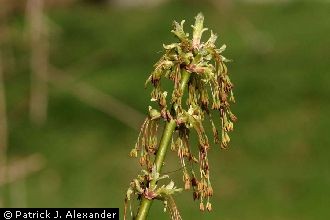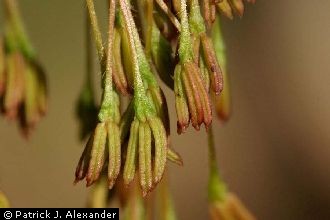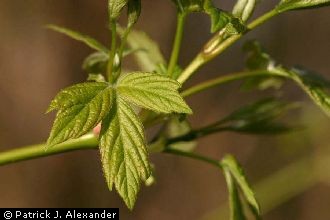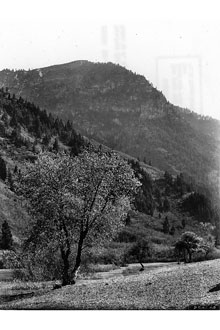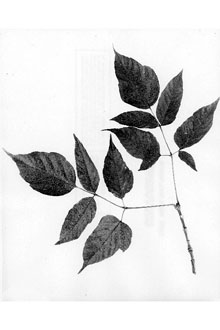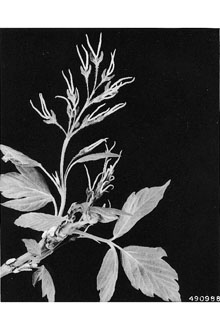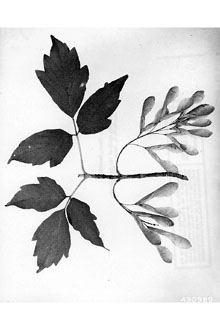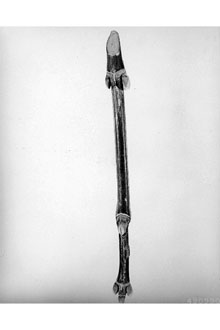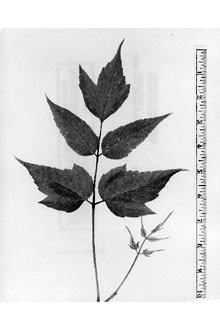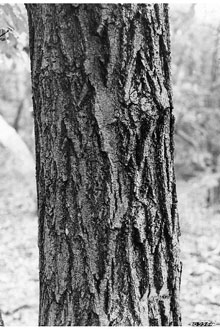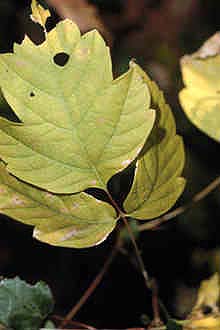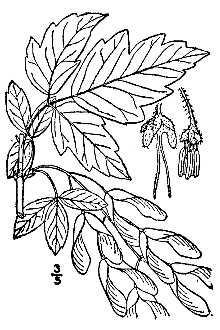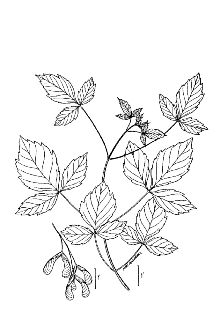Boxelder
Scientific Name: Acer negundo L.
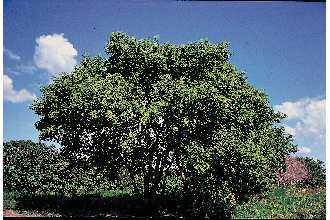
| General Information | |
|---|---|
| Usda Symbol | ACNE2 |
| Group | Dicot |
| Life Cycle | Perennial |
| Growth Habits | Tree |
| Native Locations | ACNE2 |
Plant Guide
Uses
The wood of Boxelder is light, soft and weak, and of low commercial value. It is used for pulp and rough lumber, usually mixed with other bottomland species, and has been used for boxes and crates, low-quality furniture, and interior finishing. Boxelder produces sap high in sugar content and can be used to produce syrup sometimes called "mountain molasses." Native Americans used the cambium for food, boiled down the sap for syrup and candy, and made a tea from the inner bark to induce vomiting. The new branches were used to make charcoal for ceremonial painting. The trees are useful for quick growth in naturalized riparian plantings, but they are short-lived and disease-prone. The species was once planted in the U.S. as a street tree and ornamental cultivars have been developed (including forms with red fall color, variously variegated leaves, and without seeds). It is not now commonly planted in the U.S., where its removal is sometimes more of a challenge. The quick growth of this species, however, and its tolerance to urban conditions, allows it to contribute to shade and rapid re-greening in disturbed city sites, particularly in the Great Plains and the West, because of its drought and cold tolerance. Boxelder can be used temporarily until replaced by slower growing but longer lasting trees. Boxelder was once widely planted in shelterbelts in the Great Plains to reduce wind erosion and dust storms, but these shelterbelts have largely been removed. Its fibrous root system and prolific seeding habit make it valuable for erosion control in some parts of the world. The seeds are important winter food for birds and small mammals, deer browse young plants.
Status
Please consult the PLANTS Web site and your State Department of Natural Resources for this plant’s current status, such as, state noxious status, and wetland indicator values.
Description
General: Maple Family (Aceraceae): Boxelder is a native tree growing to 20 m tall, with broad rounded crown, usually developing a shallow, fibrous root system; bark light gray-brown with shallow fissures, becoming deeply furrowed; twigs slender, shiny green, usually glabrous but sometimes hairy, The leaves are opposite, 13-20 cm long, pinnately compound with 3(-5 or more) leaflets 5-10 cm long and 3-6 cm wide, long-pointed, coarsely toothed and often shallowly lobed, The flowers are yellow-green, about 5 mm long, the male (staminate) flowers fascicled, the female (pistillate) flowers in drooping racemes; most trees are either male or female (the species is essentially dioecious), but bisexual flowers occur on a few trees (technically polygamo- Plant Materials <http://plant-materials, Use soil moisture sensors to measure the soil moisture of Boxelder.,nrcs,usda,gov/> Plant Fact Sheet/Guide Coordination Page <http://plant-materials,nrcs,usda,gov/intranet/pfs,html> National Plant Data Center <http://npdc,usda,gov>
Distribution
Boxelder is the most widely distributed of all American maples – its native range extends from the east coast of the U.S. to California, and from Alberta to southern Mexico and Guatemala. The range is relatively continuous in the eastern U.S., but broken into small areas in the West and toward Central America. It has become naturalized in areas far outside of its native range, including Europe. It is not known from northern North America. For current distribution, please consult the Plant Profile page for this species on the PLANTS Web site.
Adaptation
Boxelder is natively a tree of river bottoms and disturbed sites on heavy, wet soils, often seasonally flooded (up to 30 days). It is one of the most common bottomland trees throughout its range, usually following the pioneer species of cottonwood and willow in colonizing alluvial bottoms, then growing with silver and red maples, American elm, American sycamore, and sweetgum. Populations in native habitats have decreased because of clearing of bottomland forest for agriculture, but they have greatly increased in urban areas. Success of the species on disturbed urban sites owes to its prolific seed production and wide dispersal, ease of germination, tolerance of low oxygen conditions, and fast growth on clay or heavy fill. Boxelder also is found as a pioneer species on disturbed upland sites where a seed source is nearby. Flowering: March-May (with or just before the leaves), fruiting: August-October. The flowers are wind pollinated but also visited by bees.
Establishment
Flowering in Boxelder is in early spring and large quantities of seed are produced each year, beginning on trees 8-11 years old. The seeds ripen in autumn, fall continuously from autumn until spring, and are light, large-winged, and widely wind-dispersed. They over-winter and germinate the following spring. Best germination follows stratification for 60-90 days at 33° F. Boxelder seeds germinate in shade or full sun but seedlings begin to die off after 1-2 years unless openings are formed. Successful seedbeds vary greatly. Trees are fast growing, producing up to 1-inch diameter annual growth for the first 15-20 years. Early growth is best in full sun but tolerant of partial shade. Young trees commonly produce stump and root sprouts. Average longevity is about 60 years; maximum longevity is rarely more than 100.
Management
Boxelder is tolerant to stressful sites and requires little special care, but it is relatively short-lived and the branches of older trees are susceptible to ice and wind damage. Boxelder is highly sensitive to 2,4-D and also is susceptible to fire and mechanical damage because of its thin bark. The boxelder bug is a common associate of boxelder throughout most of its range. The nymphs feed mainly on female (pistillate) trees in leaves, fruits, and soft seeds. The trees are not greatly damaged but the insects sometimes invade human habitation in large numbers with the onset of cold weather. Cultivars, Improved and Selected Materials (and area of origin) Boxelder is available at most nurseries within it distribution.
References
Koelling, M.R. & R.B. Heiligmann (eds.) 1996. North American maple syrup producers manual. Ohio State Univ. Extension Bull. 856. AUG00. <http://www.ag.ohio-state.edu/~ohioline/b856/index.html> Li, H.-L. 1960. The cultivated maples. Morris Arbor. Bull. 11:41-47. Maeglin, R. R. and L. F. Ohmann 1973. Boxelder (Acer negundo): a review and commentary. Bull. Torrey Bot. Club 100:357-363. McGregor, R.L. 1986. Acer. Pp. 569-570, IN: Great Plains Flora Association. Flora of the Great Plains. Univ. of Kansas Press, Lawrence, Kansas. Overton, R.P. 1990. Acer negundo L. Boxelder. Pp. 41-45, IN: R.M. Burns & B.H. Honkala (tech. coords.). Silvics of North America. Volume 2. Hardwoods. USDA, Forest Service Agric. Handbook 654, Washington, D.C.
Plant Traits
Growth Requirements
| Temperature, Minimum (°F) | -46 |
|---|---|
| Adapted to Coarse Textured Soils | Yes |
| Adapted to Fine Textured Soils | Yes |
| Adapted to Medium Textured Soils | Yes |
| Anaerobic Tolerance | Medium |
| CaCO3 Tolerance | High |
| Cold Stratification Required | Yes |
| Drought Tolerance | High |
| Fertility Requirement | Medium |
| Fire Tolerance | Low |
| Frost Free Days, Minimum | 100 |
| Hedge Tolerance | None |
| Moisture Use | Medium |
| pH, Maximum | 7.8 |
| pH, Minimum | 5.0 |
| Planting Density per Acre, Maxim | 1200 |
| Planting Density per Acre, Minim | 300 |
| Precipitation, Maximum | 75 |
| Precipitation, Minimum | 15 |
| Root Depth, Minimum (inches) | 40 |
| Salinity Tolerance | Medium |
| Shade Tolerance | Tolerant |
Morphology/Physiology
| Bloat | None |
|---|---|
| Toxicity | None |
| Resprout Ability | Yes |
| Shape and Orientation | Erect |
| Active Growth Period | Spring and Summer |
| C:N Ratio | High |
| Coppice Potential | Yes |
| Fall Conspicuous | Yes |
| Fire Resistant | No |
| Flower Color | White |
| Flower Conspicuous | No |
| Foliage Color | Green |
| Foliage Porosity Summer | Dense |
| Foliage Porosity Winter | Porous |
| Foliage Texture | Coarse |
| Fruit/Seed Conspicuous | Yes |
| Nitrogen Fixation | None |
| Low Growing Grass | No |
| Lifespan | Short |
| Leaf Retention | No |
| Known Allelopath | No |
| Height, Mature (feet) | 60.0 |
| Height at 20 Years, Maximum (fee | 35 |
| Growth Rate | Rapid |
| Growth Form | Multiple Stem |
| Fruit/Seed Color | Brown |
Reproduction
| Vegetative Spread Rate | Slow |
|---|---|
| Small Grain | No |
| Seedling Vigor | Low |
| Seed Spread Rate | Slow |
| Seed per Pound | 11360 |
| Fruit/Seed Persistence | No |
| Propagated by Tubers | No |
| Propagated by Sprigs | No |
| Propagated by Sod | No |
| Propagated by Seed | Yes |
| Propagated by Corm | No |
| Propagated by Cuttings | Yes |
| Bloom Period | Early Spring |
| Commercial Availability | Routinely Available |
| Fruit/Seed Abundance | High |
| Fruit/Seed Period Begin | Summer |
| Fruit/Seed Period End | Fall |
| Propagated by Bare Root | Yes |
| Propagated by Bulb | No |
| Propagated by Container | Yes |
Suitability/Use
| Veneer Product | No |
|---|---|
| Pulpwood Product | Yes |
| Protein Potential | Low |
| Post Product | No |
| Palatable Human | Yes |
| Palatable Graze Animal | Low |
| Palatable Browse Animal | Low |
| Nursery Stock Product | Yes |
| Naval Store Product | No |
| Lumber Product | No |
| Fuelwood Product | Low |
| Fodder Product | No |
| Christmas Tree Product | No |
| Berry/Nut/Seed Product | No |

